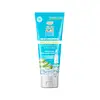What's inside
What's inside
 Key Ingredients
Key Ingredients

 Benefits
Benefits

 Concerns
Concerns

 Ingredients Side-by-side
Ingredients Side-by-side

Water
Skin ConditioningSodium Laureth Sulfate
CleansingPropylene Glycol
HumectantCocamidopropyl Betaine
CleansingPEG-150 Distearate
EmulsifyingSalicylic Acid
MaskingSodium Chloride
MaskingPhenoxyethanol
PreservativeGlycerin
HumectantSodium Hydroxide
BufferingDisodium EDTA
Styrene/Acrylates Copolymer
Sodium Benzoate
MaskingSodium Lauroyl Oat Amino Acids
CleansingPolyquaternium-39
Polyquaternium-7
Squalane
EmollientButylene Glycol
HumectantFomes Officinalis Extract
Skin ProtectingAvena Sativa Kernel Extract
AbrasiveEthylhexylglycerin
Skin ConditioningTrehalose
HumectantUrea
BufferingGlycyrrhiza Glabra Root Extract
BleachingOpuntia Ficus-Indica Stem Extract
Skin ConditioningPentylene Glycol
Skin ConditioningSerine
MaskingTerminalia Ferdinandiana Fruit Extract
AntioxidantAlgin
MaskingAnthemis Nobilis Flower Extract
MaskingCalendula Officinalis Flower Extract
MaskingCaprylyl Glycol
EmollientCentaurea Cyanus Flower Extract
AstringentChamomilla Recutita Flower Extract
MaskingDisodium Phosphate
BufferingGlyceryl Polyacrylate
Hypericum Perforatum Flower/Leaf/Stem Extract
Skin ConditioningPEG-40 Hydrogenated Castor Oil
EmulsifyingPotassium Phosphate
BufferingPotassium Sorbate
PreservativePullulan
Sodium Hyaluronate
HumectantTilia Cordata Flower Extract
Skin ConditioningWater, Sodium Laureth Sulfate, Propylene Glycol, Cocamidopropyl Betaine, PEG-150 Distearate, Salicylic Acid, Sodium Chloride, Phenoxyethanol, Glycerin, Sodium Hydroxide, Disodium EDTA, Styrene/Acrylates Copolymer, Sodium Benzoate, Sodium Lauroyl Oat Amino Acids, Polyquaternium-39, Polyquaternium-7, Squalane, Butylene Glycol, Fomes Officinalis Extract, Avena Sativa Kernel Extract, Ethylhexylglycerin, Trehalose, Urea, Glycyrrhiza Glabra Root Extract, Opuntia Ficus-Indica Stem Extract, Pentylene Glycol, Serine, Terminalia Ferdinandiana Fruit Extract, Algin, Anthemis Nobilis Flower Extract, Calendula Officinalis Flower Extract, Caprylyl Glycol, Centaurea Cyanus Flower Extract, Chamomilla Recutita Flower Extract, Disodium Phosphate, Glyceryl Polyacrylate, Hypericum Perforatum Flower/Leaf/Stem Extract, PEG-40 Hydrogenated Castor Oil, Potassium Phosphate, Potassium Sorbate, Pullulan, Sodium Hyaluronate, Tilia Cordata Flower Extract
Water
Skin ConditioningGlycerin
HumectantIsopropyl Palmitate
EmollientCaprylic/Capric Triglyceride
MaskingNiacinamide
SmoothingDimethicone
EmollientSodium Polyacryloyldimethyl Taurate
Emulsion StabilisingAloe Barbadensis Leaf Powder
Skin ConditioningCentella Asiatica Leaf Extract
Skin ConditioningHydrogenated Polydecene
EmollientAluminum Hydroxide
EmollientTocopheryl Acetate
AntioxidantTrehalose
HumectantTitanium Dioxide
Cosmetic ColorantEthylhexylglycerin
Skin ConditioningParfum
MaskingTriethoxycaprylylsilane
Trideceth-10
CleansingChlorphenesin
AntimicrobialMenthol
MaskingCalcium Pantothenate
Sodium Ascorbyl Phosphate
AntioxidantPyridoxine Hcl
Skin ConditioningMaltodextrin
AbsorbentSodium Starch Octenylsuccinate
AbsorbentSilica
AbrasiveWater, Glycerin, Isopropyl Palmitate, Caprylic/Capric Triglyceride, Niacinamide, Dimethicone, Sodium Polyacryloyldimethyl Taurate, Aloe Barbadensis Leaf Powder, Centella Asiatica Leaf Extract, Hydrogenated Polydecene, Aluminum Hydroxide, Tocopheryl Acetate, Trehalose, Titanium Dioxide, Ethylhexylglycerin, Parfum, Triethoxycaprylylsilane, Trideceth-10, Chlorphenesin, Menthol, Calcium Pantothenate, Sodium Ascorbyl Phosphate, Pyridoxine Hcl, Maltodextrin, Sodium Starch Octenylsuccinate, Silica
 Reviews
Reviews

Ingredients Explained
These ingredients are found in both products.
Ingredients higher up in an ingredient list are typically present in a larger amount.
Ethylhexylglycerin (we can't pronounce this either) is commonly used as a preservative and skin softener. It is derived from glyceryl.
You might see Ethylhexylglycerin often paired with other preservatives such as phenoxyethanol. Ethylhexylglycerin has been found to increase the effectiveness of these other preservatives.
Glycerin is already naturally found in your skin. It helps moisturize and protect your skin.
A study from 2016 found glycerin to be more effective as a humectant than AHAs and hyaluronic acid.
As a humectant, it helps the skin stay hydrated by pulling moisture to your skin. The low molecular weight of glycerin allows it to pull moisture into the deeper layers of your skin.
Hydrated skin improves your skin barrier; Your skin barrier helps protect against irritants and bacteria.
Glycerin has also been found to have antimicrobial and antiviral properties. Due to these properties, glycerin is often used in wound and burn treatments.
In cosmetics, glycerin is usually derived from plants such as soybean or palm. However, it can also be sourced from animals, such as tallow or animal fat.
This ingredient is organic, colorless, odorless, and non-toxic.
Glycerin is the name for this ingredient in American English. British English uses Glycerol/Glycerine.
Learn more about GlycerinTrehalose is a disaccharide made of two glucose molecules (glucose is sugar!). Trehalose is used to help moisturize skin. It also has antioxidant properties.
As a humectant, trehalose helps draw moisture from the air to your skin. This helps keep your skin hydrated.
Due to its antioxidant properties, trehalose may help with signs of aging. Antioxidants help fight free-radical molecules, unstable molecules that may damage your skin.
In medicine, trehalose and hyaluronic acid are used to help treat dry eyes.
Some animals, plants, and bacteria create trehalose as a source of energy to survive freeze or lack of water.
Learn more about TrehaloseWater. It's the most common cosmetic ingredient of all. You'll usually see it at the top of ingredient lists, meaning that it makes up the largest part of the product.
So why is it so popular? Water most often acts as a solvent - this means that it helps dissolve other ingredients into the formulation.
You'll also recognize water as that liquid we all need to stay alive. If you see this, drink a glass of water. Stay hydrated!
Learn more about Water